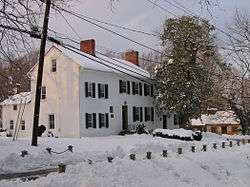Caleb Bentley

Caleb Bentley (1762–1851) was a silversmith, shopkeeper, and first postmaster in Brookeville, Maryland. Bentley was born in Chester County, Pennsylvania in 1762.[1]
In the early 1780s, Caleb emigrated with his brother, spending some time in York, Pennsylvania and then moved to Leesburg, Virginia in 1786. While in York, Bentley became a Quaker. In the early 1790s, Bentley established himself as a silversmith in Georgetown, Washington, D.C.[2] Bentley was commissioned by President George Washington to make the brass cornerstone used for the White House groundbreaking ceremony in 1792. A year later, Bentley made a silver cornerstone which was used for the United States Capitol.[3][4]
Bentley relocated to Montgomery County, Maryland in 1794, settling in Brookeville, where his wife's (Sarah Brook) family owned a large tract of land.[2] In Brookeville, Bentley opened a store and a post office in 1802, becoming the First Postmaster of Brookeville.[5] His first wife died in 1805, and two years later, he remarried to Marie Henrietta Thomas.[2] Bentley was also a founder of the Brookeville Academy,[1] and along with two brothers-in-law, established the town of Triadelphia, on the Patuxent River.[2]
Bentley's wife, Marie Henrietta Thomas, was a close friend of Dolley Madison. In August 1814, during the War of 1812, the White House was set ablaze by British troops[6] during the Burning of Washington, in retaliation for burning Upper Canada's Parliament Buildings in the Battle of York. On August 26, 1814, President James Madison fled Washington, D.C., initially going to Virginia, but then turning north towards Rockville, where he expected to find General John Henry Winder and his troops. Winder's troops had already proceeded on towards Baltimore.[2] Madison continued on eastward and arrived in Brookeville on horseback,[7] where he found refuge in the home of Caleb Bentley. Madison stayed up all night dispatching orders.[7][8][9]
The Bentleys continued to live in Montgomery County for years, though he returned to live for a period of time in Georgetown in the late 1830s. Bentley died in 1851 in Sandy Spring, Maryland.[2]
References
- 1 2 Farquhar, Roger Brooke (1952). Old Homes and History of Montgomery County, Maryland. Judd & Detweiler, Inc. pp. 207–208.
- 1 2 3 4 5 6 Allen, William C. (1995). In The Greatest Solemn Dignity — The Capitol's Four Cornerstones. Government Printing Office. pp. 12–13.
- ↑ Allen, William C. (1995). In the Greatest Solemn Dignity — The Capitol's Four Cornerstones. Government Printing Office. p. 7.
- ↑ Allen, William C. (2001). History of the United States Capitol — A Chronicle of Design, Construction, and Politics. Government Printing Office. p. 24.
- ↑ Siegal, Ann Cameron (2007-12-01). "Charms and Challenges Of a Tiny Old Town". The Washington Post.
- ↑ "The East Room". White House Historical Association. Retrieved 2007-11-02.
- 1 2 Landphair, Ted (2007-08-15). "You Won't Need Much Time to Tour This 'Capital'". VOA News.
- ↑ "Brookeville: Gem from the Past". Sandy Spring Museum. Archived from the original on 2007-10-07. Retrieved 2007-12-14.
- ↑ Browning, Charles Henry (1895). "President Madison's Retreat". The American Historical Register. Historical Register Pub. pp. 857–861.
External links
- "Caleb Bentley," Biography, Maryland State Archives [MSA SC 3520-15889]
- Brookeville 1814, Maryland State Archives